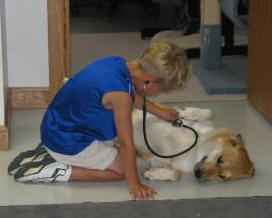"Ms. Kinder, there's dog feces in the sandbox," said the young Claire.
Edward and Peanut at work

Edward plays doctor with his dog, Peanut, at his mom's clinic. Photo by Dr. Teri Ann Oursler.
It can be hard growing up as the child of a veterinarian. They tend to be exposed to certain language and topics long before most children. For instance, I have a friend who was reprimanded when her preschool-aged daughter Claire used language the school deemed inappropriate.
One day when Claire and her classmates were let loose onto the playground, Claire stopped all of her friends from going into the sandbox. Concerned about something she saw, she ran to tell her teacher.
“Ms. Kinder, there's dog feces in the sandbox,” said the young Claire.
Claire's mother got a call to meet with the school director and teacher. Apparently, the use of the word feces was offensive to Ms. Kinder and deemed bad language for a child to be saying. Poop was considered more acceptable.
Bodily functions, including reproduction, can be a delicate topic for kids. For many years, I worked at a municipal animal shelter. Large swaths of my workdays were filled with spaying and neutering cats, dogs, and rabbits. So naturally, conversations at dinner focused on what I'd seen at work that day during surgery. Anyone who's ever had a romantic relationship with a veterinarian knows what this is like. At any given meal there is bound to be at least one food item that makes the veterinarian say, “You know, this ketchup/linguine/cottage cheese reminds me of my 10 o'clock today.” Partners learn to roll with it or to eat before the veterinarian comes home.
When you're doing that many surgeries removing reproductive organs, your kids learn all about reproduction much earlier than other children. And not just the basics! Oh no! They learn about terms like hermaphrodite (where an animal has genitalia consistent with a male and a female) and cryptorchid (where one testicle does not descend into the scrotum as it should). They may even remember how many uterine horns cats and dogs have (two). In fact, my children could probably have described how to perform a Miller's knot or a pedicle tie, both ligation techniques, by the time they were in fourth grade. One friend who was very squeamish at the idea of talking about the birds and the bees with her children swore that she would have me do the task for her (it didn't happen although I told her I would if she really wanted me to).
But it's not just reproduction. Kids of veterinarians learn that we keep things in jars. Ticks. Teeth. Worms.
Dr. Sherri Wilson’s 3-year-old accompanied her to a clinic when she was doing mobile endoscopy, meaning she would travel from clinic to clinic using an endoscope to look inside such places as stomachs and rectums. Of course, trying to work with your little kid in tow is a whole ‘nuther article on the trials of being a veterinarian-parent. Not only was Sherri “gifted” two free bunnies at one location (“Thanks?”), one of which lived for 12 years, but at the next stop they could see a surgery in progress.
“My daughter kept looking through the door, so I kicked the door closed. She asked 'are they doing something with that cat's eye?' It was an enucleation and I could picture the nightmares coming if she saw this. I said...'some trouble with the eye.’ She kept looking through the window and finally said, ‘Are they taking the eye out?' Well, yes - it's probably really hurt and the cat will feel much better after this.’ There was a long silence and then…'CAN I HAVE IT?' She had that thing in a formalin jar in her bedroom for years."
The staff was encouraged by her interest and brought out all the jars of crazy things they had for Sherri’s daughter to look at: the ticks, the heartworms, etc. She loved all of that. They asked her if she wanted the uterus from the cat they spayed next. Of course she did. On the way home, she told Sherri that now “We could have kittens because we've got this uterus.”
Caitlin, the daughter of Dr. Christy Corp-Minamiji, used to ride with Christy when she was in kindergarten to about second grade. Caitlin once held the prolapsed uterus of a sheep up while Christy cleaned, sutured, and replaced it. This event caused some consternation in Caitlin’s Catholic school kindergarten when the teacher asked what they had done over spring break.
Much of my work now centers around animal abuse. My children can explain the connection between animal abuse and interpersonal violence and know the significance of fractures in different stages of healing. I have to remember that what they are used to hearing is not typical in many homes. Their friends learned to not ask too many questions about what I do and what's that smell when they were at our home B.C. (before Covid-19).
On the plus side, the children of veterinarians have ample opportunity to play with kittens and learn proper behavior when meeting a new dog earlier than most kids. At a minimum, being the child of a veterinarian provides good stories to tell friends and a strong stomach. Anyone for some litterbox cake?